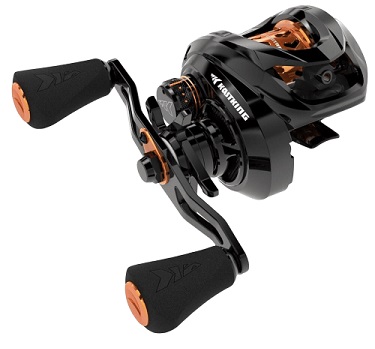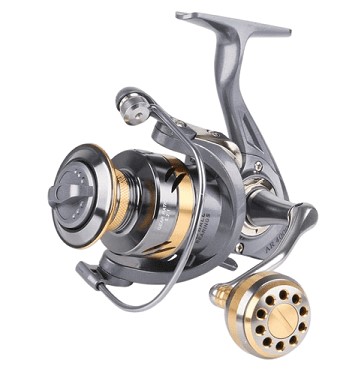
Gear Ratio in Multiplier Fishing Reels
When it comes to fishing reels, one crucial factor that greatly influences your angling performance is the gear ratio. The gear ratio plays a vital role in determining the speed and power of your line retrieval. In this section, we will delve into the concept of gear ratio specifically for multiplier reels, helping you understand its significance and make informed decisions when choosing the right gear ratio for your angling exploits.
The Basics of Gear Ratio
To comprehend gear ratio, envision the gears within a multiplier fishing reel. The gear ratio represents the number of times the spool rotates for each full revolution of the handle. It is typically expressed as a numerical ratio, such as 4.5:1 or 6.2:1. The first number denotes the rotations made by the spool, while the second number indicates a complete turn of the handle.
High Gear Ratio (Speed and Efficiency)
Multiplier reels with higher gear ratios, such as 7:1 or even 8:1, are known for their swiftness and efficiency in line retrieval. These reels excel in scenarios where quick lure presentation or rapid retrieval is desired, such as when using fast-moving baits or engaging in topwater fishing. With a high gear ratio, you can cover more water in less time, increasing your chances of enticing a strike.
Low Gear Ratio (Amplifying Power and Control)
On the other end of the spectrum, multiplier reels with lower gear ratios, such as 4:1 or 5:1, offer enhanced power and control. These reels are ideal for situations that demand greater torque and pulling strength, such as deep water fishing or when using heavy baits. The slower retrieve speed allows you to exert more force when battling stubborn fish, enabling you to exert steady pressure and increase your chances of landing a prized catch.
Choosing the Right Gear Ratio
Selecting the appropriate gear ratio for your multiplier fishing reel depends on several factors:
- Fishing Technique/Style: Consider the specific techniques you employ most frequently. For techniques requiring a faster retrieve, opt for higher gear ratios. For techniques requiring greater power, lower gear ratios are preferable.
- Target Species: Different fish species exhibit varying behaviors and preferences. Understanding the habits and tendencies of your target species can guide your gear ratio selection. Aggressive and fast-moving fish might be enticed by high gear ratios, while larger, hard-fighting species may necessitate lower gear ratios.
- Preferred Lure Types: The type and weight of lures you frequently use influence the gear ratio as well. Lighter lures work well with higher gear ratios, while heavier lures benefit from lower gear ratios for better control and casting accuracy.
Summary
Gear ratio is a fundamental aspect of multiplier fishing reels that significantly impacts your angling experience. Whether you prioritise speed, power, or a balance of both, understanding the nuances of gear ratio allows you to make informed decisions when selecting a reel for your specific fishing needs. Experimenting with different gear ratios based on fishing techniques, target species, and lure types will empower you to optimise your angling success. So, next time you gear up for a fishing adventure, pay close attention to the gear ratio and unlock the full potential of your multiplier fishing reel.
Gear Ratio in Fixed Spool Fishing Reels

Fishing enthusiasts often find themselves faced with a wide array of gear options, each designed to enhance their angling experience. Among the essential components of a fishing reel is the gear ratio, a factor that greatly influences the reel’s performance. In this section, we will delve into the concept of gear ratio and explore its significance in fixed spool spinning reels.
Understanding Gear Ratio
Gear ratio refers to the relationship between the number of revolutions made by the reel’s spool for each turn of the handle. It is expressed as a numerical ratio such as 4.5:1 or 6.2:1, where the first number represents the number of spool revolutions, and the second number indicates one complete turn of the handle. Essentially, the gear ratio determines the speed at which the line is retrieved.
Effects of Gear Ratio on Fishing
High Gear Ratio
A high gear ratio, such as 7:1 or higher, means the spool will make more revolutions for each handle turn. This results in a fast retrieval rate, making it ideal for techniques that require quick lure presentation or when covering large areas of water. High gear ratios are particularly advantageous for techniques like topwater fishing, where a rapid retrieve is necessary to create surface disturbance and trigger strikes.
Low Gear Ratio
Conversely, a low gear ratio, typically around 4:1 or lower, indicates fewer spool revolutions per handle turn. This slower retrieval speed provides increased power and torque, making it suitable for situations that demand greater strength. When using heavy baits or fishing in deep water scenarios, a low gear ratio helps maintain control and enables effortless handling of substantial resistance.
Choosing the Right Gear Ratio
Selecting the appropriate gear ratio for your fixed spool fishing reel depends on several factors:
- Fishing Technique/Style: Different techniques require specific gear ratios. For finesse fishing or situations that demand precise lure control, a lower gear ratio can be more beneficial. On the other hand, if you prefer casting and retrieving lures quickly, a higher gear ratio will be more suitable.
- Target Species: Consider the behavior and characteristics of the fish you are targeting. Fast-swimming species may require a high gear ratio to keep up with their movements, while slower or bottom-dwelling fish might be better pursued with a lower gear ratio.
- Preferred Lure Types: The type and weight of lures you frequently use also play a role. Lighter lures are better suited for higher gear ratios, as they require less effort to retrieve efficiently. Heavier lures, on the other hand, benefit from the increased power and control offered by lower gear ratios.
Summary
Understanding gear ratio is crucial for optimising your fixed spool fishing reel’s performance. The right gear ratio allows you to adapt to various fishing techniques, target species, and lure types. Whether you opt for a high gear ratio for quick presentations or a low gear ratio for added power, finding the perfect balance will significantly enhance your angling experience. Experiment with different gear ratios, and remember to consider your fishing preferences and conditions to select the ideal gear ratio for your needs.
